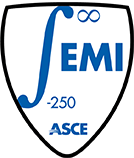Poromechanics of Damage and Healing: A Philosophy of the Mesoscale
Georgia Tech
Problems
Damage is an abstract concept, generally associated to the ideas of degradation, decrease of performance or loss of reliability. Because damage is tied to the notion of deprivation, its definition is relative to a reference state and its measure depends on standards considered as relevant observation tools by the modeler. Damage prediction relies on the field variables chosen to describe the anticipated "degradation", "loss" or "deprivation". That is the reason why framing a damage model is necessarily a dynamic thinking process, well described by Claude Bernards' OHERIC approach: Observation‐Hypothesis‐ Experimentation‐Interpretation‐Conclusion. Healing can be understood as the microscopic processes underlying observable compensation (or recovery) of damage. However, while there is no consensus on the definition of healing in geomaterials, proven crack "sintering" and "re‐bonding" do not stem from the same physical processes as the ones originating damage. The fundamental question is: "What do we want to observe?" In other words: "What is the mesoscale"?
Approach
We formulate energy‐based damage and healing models for geomaterials - mainly rock and cement‐ based materials. The underlying theoretical background comprises fundamental thermodynamics, poromechanics, Continuum Damage Mechanics, micro‐mechanics and homogenization schemes. Starting from observations reported by experimentalists, we postulate the form of thermodynamic potentials, and we define macroscopic variables that can be coupled to microscopic variables describing fabric evolution with crack opening, closure and healing. Most of our work focuses on damage - induced anisotropy of stiffness and permeability.
Findings
The keys for damage and healing phenomenological modeling are (1) the choice of descriptors, i.e. the choice of a set of independent and complete variables relevant to the macroscopic properties under study, (2) the scales of the observation window, i.e. the length scales at which a continuum rheology may and need to be defined. Emphasis is put on how descriptors evolve across the observation scales.
- An alternative damage model was formulated in independent strain variables, allowing to account for thermo‐hydro‐mechanical couplings in unsaturated brittle rock,
- An exploratory damage and healing model was proposed, based on the evolution of an intermediate internal variable ‐ defined as the difference between a rate‐independent damage variable and a rate‐ dependent healing variable,
- A novel permeability model was formulated to update microscopic Pore Size Distribution (PSD) parameters with macroscopic deformation and damage,
- A thermodynamic framework was proposed to model crack opening, closure and healing for one single crack embedded in a solid matrix.
Impact
The proposed approach allows predicting crack patterns around geological storage facilities and ahead of fracture tips, which is a central issue in energy geotechnics. Models are also expected to contribute to the design of self‐healing geomaterials for sustainable infrastructure. The philosophical question is: does a (fixed) mesoscale exist, and is it unique?
Core competencies
- Constitutive Modeling: damage and healing in rock, influence of microstructure on macroscopic properties, thermo‐hydro‐ chemo‐mechanical couplings in porous media.
- Numerical Modeling: MATLAB, Finite Elements, Discrete Elements.
- Energy Geotechnics: nuclear waste disposals, compressed air storage, carbon dioxide sequestration, geothermal systems, hydraulic fracturing.
Current research team members:
- Chloé Arson (PI)
- Hao Xu (PhD student)
- Cheng Zhu (PhD student)
Recent graduates and co‐workers:
- Nathalie Dufour (PhD 2011) : visiting Ph.D. student (Spring 2011), Ecole Nationale des Travaux Publics de l'Etat, France
- Benjamin Juge (supervised M.Sc. 2011) Erin Berns (supervised Undergraduate 2011)
- Mathew Hong (supervised Undergraduate 2011)
- Abenezer Nida (supervised Undergraduate 2010)
Current research collaborations:
- Numerical algorithms for a constitutive model coupling damage and plasticity in unsaturated geomaterials - Solenn Le Pense, visiting PhD student, Navier Laboratory, Ecole des Ponts ParisTech, France
- Multi‐scale modeling of permeability in damaged rock ‐ Jean‐Michel Pereira, Researcher, Navier Laboratory, Ecole des Ponts ParisTech, France
- Stiffness Homogenization of the hybrid layer in teeth treated with resin comppsites - Elsa Vennat, Assistant Professor, MSSMat Laboratory, Ecole Centrale Paris, France
- Characterization and Modeling of Cement Paste Thermal Damage Using Acoustic Waves ‐ Zoubeir Lafhaj, Professor, Lille Mechanical Laboratory, Ecole Centrale Lille, France
- Damage and healing‐induced anisotropy in salt rock ‐ Fred Chester, Professor, Department of Geology & Geophysics, Texas A&M University
- Role of AC diffusion potentials in decontamination using poultices, J. Carlos Santamarina, School of Civil and Environmental Engineering, Georgia Institute of Technology


